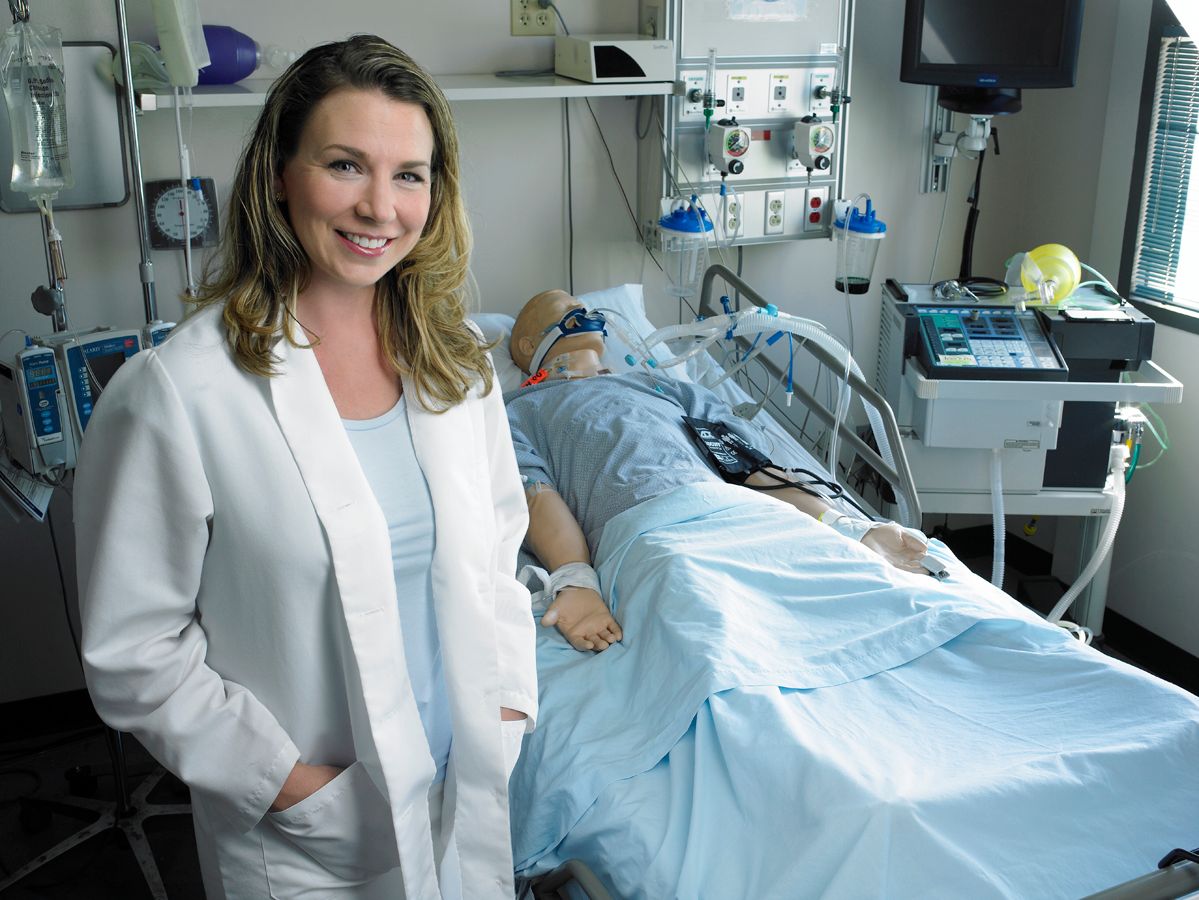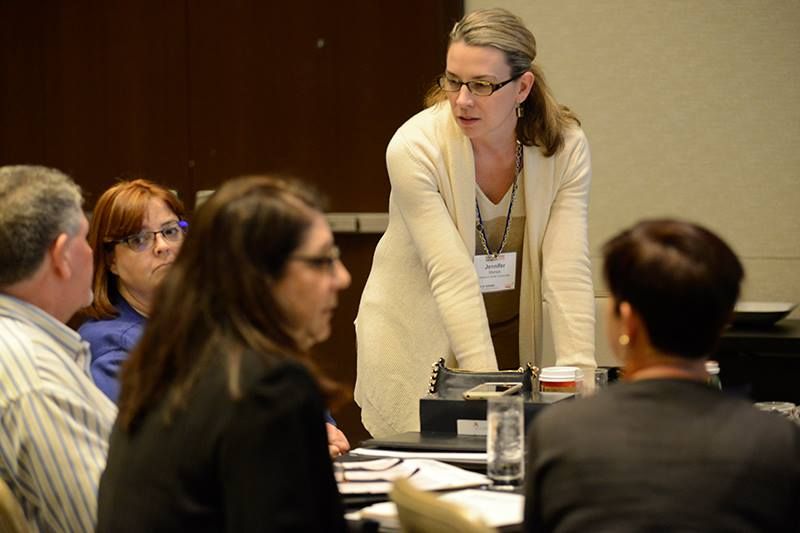American Nurses Association’s new president says nurses need more support
Jennifer Mensik Kennedy, who took the post earlier this month, said nurses need more than occasional pizza parties. Healthcare leaders need to change their work environment to help nurses thrive, she says.
Jennifer Mensik Kennedy is the new president of the American Nurses Association. (Photo: American Nurses Association)

As thousands of nurses in New York City went on strike last week, Jennifer Mensik Kennedy spoke out to support them.
Mensik Kennedy is the new president of the American Nurses Association, the advocacy organization which represents more than 4 million registered nurses nationwide. While the association wasn’t involved in organizing the walkout, she sought to make sure she had the nurses’ backs.
“When a strike of this scale occurs, it is typically indicative of a systemic breakdown to provide safe staffing levels, protect nurses from workplace violence, support nurses’ mental health and well-being, and resolve other work environment challenges,” she said in a statement.
After a three-day strike, the nurses announced they reached a tentative deal with Montefiore Medical Center and Mount Sinai Hospital. The nurses received commitments to boost staffing, including specified nurse-patient ratios, along with raises of about 19% over the next three years.
Mensik Kennedy told Chief Healthcare Executive that she expects to see intense labor battles between nurses and hospitals - and the potential for strikes in the near future.
For too long, nurses have tried to call attention to problems with their work environment and haven’t been heard.
“We’ll see more nurses walk out, if the systems do not listen,” she said in an interview earlier this month. “Nurses don’t want to have to do that. They want to take care of patients.”
“People do need to pay attention and really work with nurses,” she said.
Mensik Kennedy, who took the post on Jan. 1, previously served as the division director of care management at Oregon Health and Science University in Portland, Oregon talked with Chief Healthcare Executive about the struggles of nurses, her thoughts on what hospital leaders can do to support nurses, and her goals in her new position.
“The hospital structure has been a difficult place to work in,” Mensik Kennedy said.
“If we want individuals to be working in healthcare settings, we need to look at the environment in which people are practicing,” she said.
Jennifer Mensik Kennedy, the new president of the American Nurses Association, says healthcare leaders need to include nurses in decisions on patient care. (Photo: American Nurses Association)

‘A problem for decades’
Many nurses have left hospitals during the COVID-19 pandemic, and plenty of other nurses have indicated they are thinking of walking away. Nurses have worked demanding hours, particularly amid staffing shortages, and some say they have been drained physically and mentally.
However, nurses have been trying to raise awareness of the difficult environment in hospitals long before the emergence of COVID-19.
“This has been a problem for decades,” Mensik Kennedy said. “The pandemic was the straw that broke the back.”
“It’s about things that were a problem before COVID,” she continued. “It’s about shared leadership and nurses feeling valued.”
Many nurses don’t feel valued for what they are contributing to patient care, she and other nursing leaders said. Nurses often aren’t included in efforts to improve operations, or their suggestions are often ignored when they are invited to offer their ideas, she said.
“People don’t feel heard,” Mensik Kennedy said.
Healthcare leaders have talked about building resilience in their nursing staff in the pandemic, but in her view, that’s missing the bigger picture.
“It’s not about making people more resilient,” she said. “How do we make the work environment more conducive? Nurses want to provide good, quality patient care.”
Mensik Kennedy said there’s a greater need to address the well-being of nurses.
“It’s not just an occasional pizza party,” she said. “It’s having managers and leaders respect them for their knowledge and value what they do.”
“To make significant changes, it’s going to take managers and the C-Suite to be leaders.”
Hospitals can show they value their nurses by giving them greater leadership roles and incorporating their perspectives in decisions involving patient care, Mensik Kennedy said.
“You can’t make successful positive change in the work environment without having the nurses and clinicians there side-by-side to make those decisions,” she said.
Few nurses are sitting on the boards of healthcare organizations, Mensik Kennedy said. “That’s where it really needs to start,” she said. “We can’t always rely on the chief nurse executive to be that voice.”
Let nurses practice nursing
Nursing leaders have said many nurses are frustrated with the number of tasks they have been asked to do that go beyond typical nursing duties, such as changing linens and emptying garbage cans.
Mensik Kennedy said it’s not that nurses are above those tasks, but nurses are routinely being asked to monitor more patients. Those extra duties become more stressful when nurses are trying to give patients their medication or watch those at risk of falls.
Hospitals are seeing patients with more advanced illness, since many deferred care during the pandemic. Those patients require more attention, Mensik Kennedy said.
“Patients are sicker,” she said.
Hospital leaders need to examine their workplace culture and ask, “What can we do to have nurses practice nursing?”
Healthcare leaders can help take care of their nurses, and address some of their own staffing difficulties, by moving to more flexible scheduling options, Mensik Kennedy said.
Some nursing leaders have suggested it’s time for hospitals to rely less on 12-hour shifts. While some nurses like working a few 12-hour shifts and then having three or four days off, those longer shifts can be more challenging for nurses with children and older nurses. Nearly half of the nation’s registered nurses are over the age of 50, according to a federal report.
“There are some nurses who may not be able to do a 12-hour shift,” she said. Hospitals that are less rigid in scheduling can help improve nurse being, and possibly ease some of their own staffing headaches.
Health systems need to take a more nuanced look at staffing, Mensik Kennedy said.
“We think of nurses as bodies,” she said.
Hospitals sometimes make the mistake of simply looking at the number of nurses on a given shift without considering their experience, she said.
If one of those nurses is new and inexperienced, that nurse is going to require more mentoring and guidance, Mensik Kenney said. It’s critical to provide staffing and ensure younger nurses have someone available to offer guidance and help train them, so they don’t become overwhelmed and disenchanted and end up walking away.
“That’s vital for keeping nurses,” she said.
Addressing racism in nursing
Nurses in minority groups have said they have routinely endured racism in their profession. Mensik Kennedy said addressing racism is one of her top priorities.
The American Nurses Association has acknowledged it needs to provide more support for nurses of color. The ANA released a “Racial Reckoning Statement” in July apologizing for the organization’s role in perpetuating systemic racism.
Nearly half of 5,600 nurses surveyed said racism was widespread, according to the report by the National Commission to Address Racism in Nursing. Almost all Black nurses surveyed (92%) said they have experienced racism at work, and 70% said it came from leaders, while 66% said it originated from peers.
While her organization has conceded its past failings of nurses in minority groups, Mensik Kennedy said she aims to go beyond apologies. “We need to operationalize what this means,” she said.
The association is aiming to provide resources to help organizations remove structural barriers and bias in the workplace.
Health systems should aim to change their workplace culture by steps such as hiring chief diversity officers and offering training on implicit bias.
However, she said, “Education can’t be where we end.”
Healthcare leaders: Prepare for a very different HIPAA security rule | Viewpoint
April 20th 2025The proposed changes to the HIPAA Security Rule are significant. Executives and boards need to prepare as the days of voluntary compliance end and a new era where leaders are held personally accountable emerges.